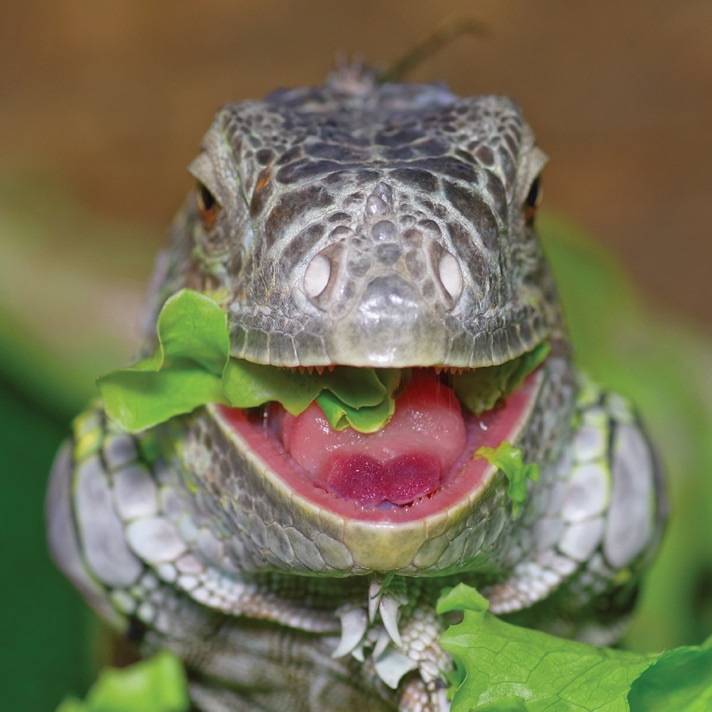Despite setbacks, the Lizard King’s popularity endures.
As far as the reptile trade goes, the green iguana has got to be the unequivocal king of all lizards. To the laymen, the word “iguana” seems to be virtually synonymous with the word “lizard.” I cannot count the number of times I have been asked, “What kind of iguana is that?” regardless of whether I was holding an iguana, monitor, leopard gecko or even a bearded dragon!
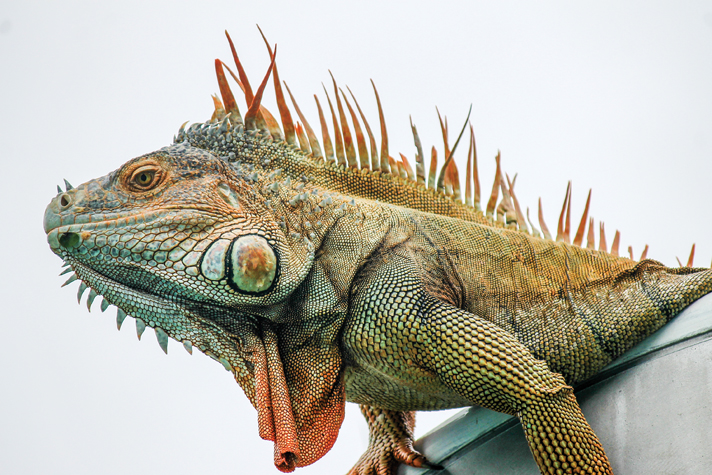
anacrismont/shutterstock
This iguana has some truly impressive spinage!
Most of the reptile books that I grew up reading were published or reprinted in the 1960s and 70s, and they provided strong exposure to the remarkable green iguana, with many photos of this majestic beast. Pet stores of my youth always had impressive examples of adult green iguanas on display, as if a symbol of the stronghold reptiles, as well as other “odd pets” of the time, were building within the industry, and an icon of promising things to come.
Green Iguana Popularity and Setbacks
For decades, the green iguana has been a staple in the pet trade, with hundreds of thousands being imported from iguana farms in central and South America. To this day, in portions of its natural range, the green iguana is a viable source of revenue, and the extensive farming industry specifically for the pet trade employs many people, including some who might normally have no other employment opportunities. As the green iguana is a CITES Appendix II species (meaning that while it is not threatened with imminent extinction, trade is controlled) a portion of the farmed iguana offspring are released back into the wild as part of an agreement with the farmers.
In 1997, more than 640,000 juveniles were imported to the U.S. as pets, and magazines such as REPTILES, Reptile & Amphibian and others helped educate hobbyists on how to successfully keep green iguanas alive in captivity. Previously, thousands perished due to impulse purchases from mostly ignorant keepers with no idea how to maintain them. With good information becoming more available, the green iguana’s popularity surged.
But there was trouble on the horizon, especially when the green iguana came to be associated with Salmonella for a time in the mid 1990s. The favored pet was transformed into a possible vector of disease, despite the fact that prevention of salmonellosis required nothing more than basic cleaning practices. Always wash your hands after handling an iguana, and never handle them in areas where food is prepared. Supervise children who are handling them, too, and make sure they wash, too. Of course, reptile-related Salmonella scares were nothing new, especially since in 1975 it became illegal to sell turtles with a carapace length of less than 4 inches due to cases of children contracting salmonellosis from juvenile red-eared sliders.
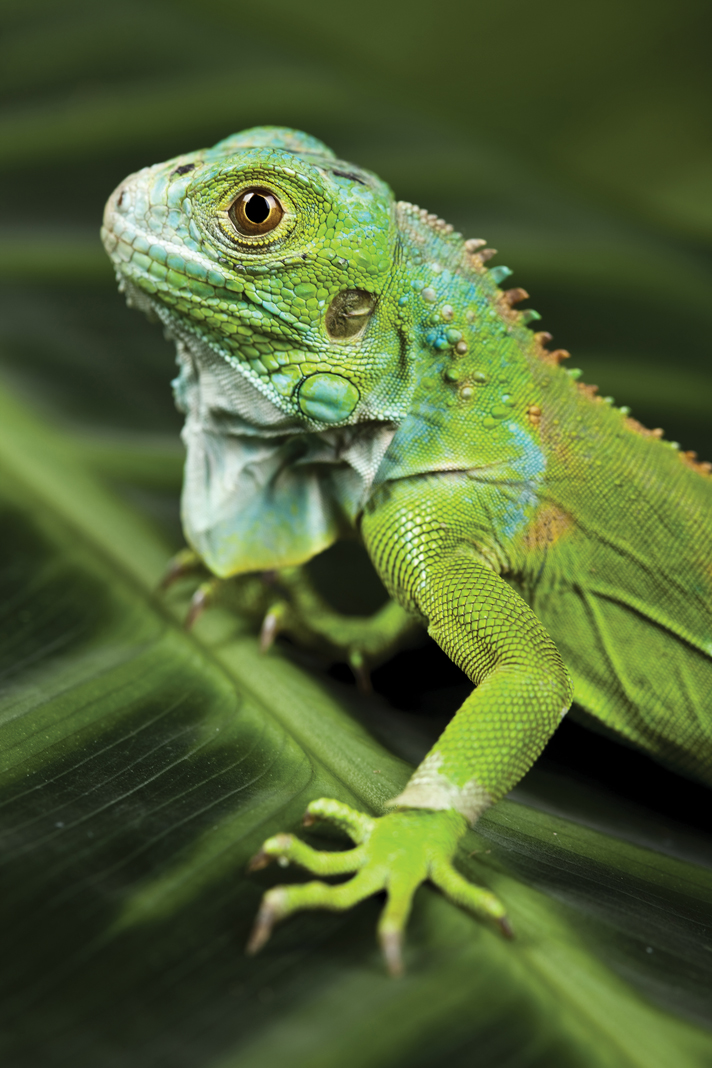
sebastian duda/shutterstock
Bright-eyed youngsters are tempting to buy, but remember that they will grow into very large adults with special caging requirements.
Also affecting the green iguana’s pet popularity was the eventual realization by hobbyists that proper care for a green iguana could be difficult to provide due to the lizard’s adult size, temperament of males during breeding season (they have strong jaws and teeth, not to mention infamously long nails if left untrimmed [see sidebar]) and high humidity requirements. Even though this realization likely affected the number of green iguanas being sold as pets, it’s still a good thing because it meant fewer impulse purchases and resulting deaths of mishandled animals. These days, hobbyists who keep green iguanas are better informed, more prepared and thus able to provide a proper environment for their pets. With the relatively quick drop in interest in pet iguanas compared to what it was previously, the Los Angeles County Department of Public Health reported a drop in iguana-related salmonellosis from 30 percent of cases in 2001 to 1 percent by 2006.
For these reasons, and due to the spectacular captive-breeding success of ball pythons, leopard geckos and bearded dragons, the pet industry shifted its focus to these less “notorious” species with less stringent care requirements.
Today, though not kept by as many people as in years past, the green iguana remains a stalwart in the pet industry. And for breeders who wish to work with them, there is still the potential for profit. Reptile kingpin Tom Crutchfield, for instance, has produced some beautiful green iguana color variants exhibiting shades of red, blue, yellow and orange. Some of these come with price tags of $10,000 per lizard!
A Most Majestic Lizard
First described by the father of formalized binomial nomenclature, Swedish zoologist Carl Linnaeus, the green iguana was taxonomically classified as Iguana iguana in 1758. Found throughout southern Mexico, central America and central Brazil, the species is also native to the Dominican Republic, Paraguay and Bolivia, and green iguanas can be found naturally throughout most of the Caribbean islands. They have been introduced and are classified as an invasive species in many tropical and sub-tropical locations, including Texas, Florida, Hawaii and the U.S. Virgin Islands.
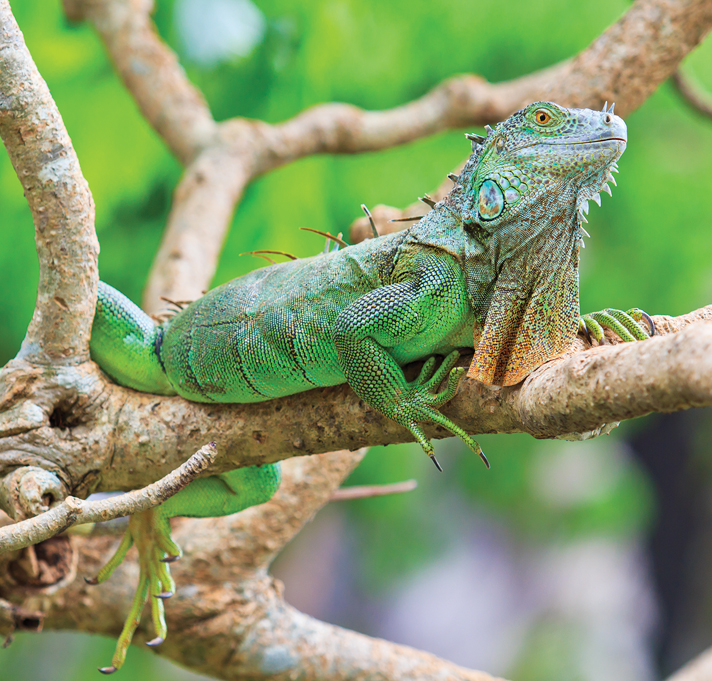
apiguide/shutterstock
Iguanas love to climb, and their enclosures should include plenty of sturdy branches. Outdoor enclosures offer the additional benefit of unfiltered sunlight.
A large male green iguana can reach lengths of 6 feet, while females average about 4 feet. Nearly two-thirds of an iguana’s length is comprised of the tail. Though both males and females can be fairly stocky, adult males tend to be heavier and more bulky. Males often sport brighter coloration, and not just emerald green, but also combinations of orange, green and blue. Males have much larger heads than females, with a large, fatty jowl behind each subtympanic plate. These heavy jowls likely serve as additional throat protection during ritualistic male-on-male combat. A large dewlap is also present in males and is used for visual communication and thermal regulation. Mature male green iguanas, like males of other lizard species, possess enlarged femoral pores. These can grow so large in green iguanas as to appear comb-like, and they can help easily identify one sex from the other.
Female green iguanas tend to be more drab in color as adults, typically exhibiting shades of brown, gray and green. They have a more streamlined appearance with a modest head and neck size, and a much smaller dewlap than the males.
Both sexes possess visible, external tympanic membranes for hearing and are adorned with heavy scalation along the dorsal and lateral areas of the throat. There is also a translucent parietal eye or pineal gland on top of the head. Though the parietal or “third eye” does possess rudimentary vision apparatus, it is unable to make out collective images, “seeing” only shadows of light and dark. It may give early warning of dangers approaching an iguana from above.
The tail of a green iguana is rigid and rough in texture, and it makes an excellent weapon when used defensively. It is adorned with dark bands that help to camouflage iguanas while resting among the shadows of tree branches. The large tail also assists with balance as a lizard moves swiftly along the ground or among the treetops. It also helps propel an iguana while swimming.
Both male and female green iguanas are equipped with spiny, keratin protrusions, or spines, that run from behind the head and along the spine down to the tip of the tail, reducing in size progressively. These protrusions are thin and vascular, and they likely aid with thermal regulation, acting much like miniature solar panels.
Pet Iguana Care
There are some crucial requirements to keeping green iguanas healthy and long-lived in captivity that cannot be ignored. In nature, green iguanas are active animals with social and territorial routines that are often orchestrated based on temperature and light intensity. Although their natural environment is virtually impossible to duplicate exactly in captivity, there are steps that keepers can take to create a proper living space for a pet green iguana.
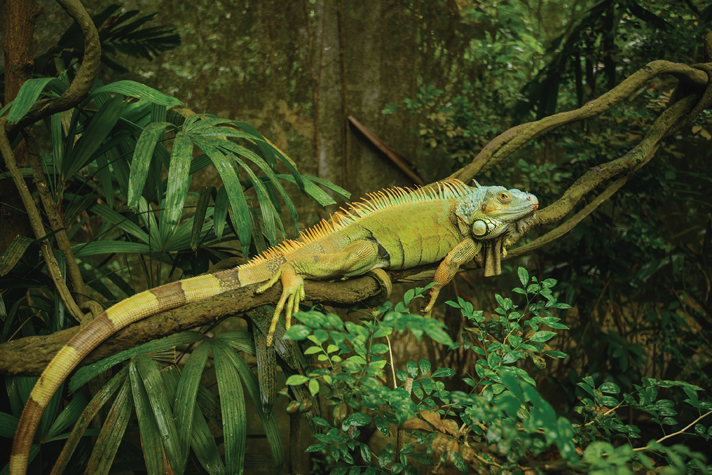
red-feniks/shutterstock
Planting a green iguana vivarium with live plants can result in a gorgeous setup, but the plants may be trampled or eaten.
They need a lot of space, the sort that may be available only by building a custom enclosure. Ideally, a single adult green iguana should be housed in an enclosure that is at least 4 to 6 feet wide and up 8 feet tall.
Many people will purchase a baby iguana and keep it in a smaller enclosure, such as a 20-gallon long reptile terrarium, figuring they will work their way up to increasingly larger enclosures as the lizard grows. This can work, but if the iguana is cared for properly it will grow quickly. Plus, green iguanas kept in glass tanks quickly become hidden behind a thick film of salt, which they frequently “sneeze” onto the glass via a lateral nasal gland specifically designed for the excretion of extra salt that is not lost through the typical renal system. This looks gross and is a pain to clean.
It’s really more practical to start with an enclosure that is large enough for an adult at the outset, and let younger iguanas grow into it. I have seen spare rooms and large closets converted into iguana enclosures, as well as bureaus and other large furniture. Get creative, and you and your iguana will benefit from the extra effort. And if you live in an area where the weather can allow your custom iguana caging to be set up outdoors, so much the better.
If you must provide a juvenile with a temporary smaller enclosure such as a glass terrarium (but again, what happens when your pet grows larger?), be sure to utilize a screened cover so you can provide the proper UVB light. Lighting is just as important as space when it comes to green iguana husbandry, and although no commercial light is equivalent to providing natural, unfiltered sunlight to a green iguana, there are some specifically manufactured with captive iguanas that are kept indoors in mind. Reptile supplies are much more accessible both in pet stores and online reptile shops.
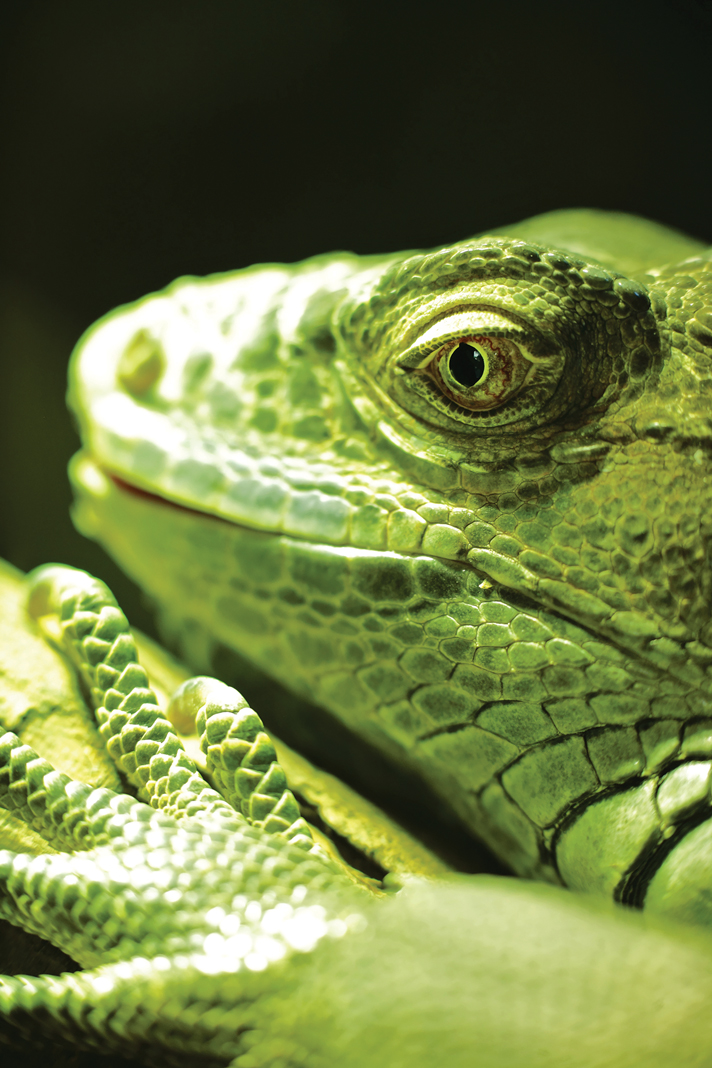
leungchopan/shutterstock
Proper ultraviolet lighting is important for green iguanas that are housed indoors.
Reptile heating and lighting is essential for iguanas, which require UVA and UVB full-spectrum lighting over their enclosures to properly process the vitamins and minerals required for normal body function. A reptile light fixture is always required with these bulbs. It is important for overall mental and physical condition as it prevents a variety of disorders commonly associated with green iguanas, including rickets and metabolic bone disease (sometimes called “rubber jaw”). The good news is the right type of lighting can be purchased online or at pet stores, and you can choose from an assortment of reliable brands, including Zoo Med, Exo Terra and Zilla. Be sure to follow the manufacturers’ instructions for use, especially in regard to where to place the bulbs and how often to replace them.
A green iguana enclosure should be maintained at ambient temperatures between 80 and 85 degrees Fahrenheit, with a basking area, provided by an overhead heat light or emitter, that’s between 90 and 95 degrees. Use a heat gun and reptile thermometer to keep track of temperatures at the various locations within the enclosure. There can be a slight drop in temperature at night, there can be a slight drop, but I don’t recommend it be allowed any lower than 75 degrees.
Iguanas often defecate in their water bowls, so daily water maintenance should be a priority. A large water container that allows soaking, or even some swimming, should be provided. This will also help maintain humidity in the enclosure. A humidity level of 70 to 80 percent should satisfy your iguana’s requirements. Misting, either using a hand mister, like the Exo Terra Reptile Mister, or automated system, can also help provide humidity. Iguanas will often drink water droplets off of cage décor. You can measure humidity with a variety of reptile hygrometers.
Speaking of décor, be sure to provide plenty of sturdy climbing branches and cover for your iguana. Green iguanas like to climb as high in their enclosures as possible, to feel secure. Creating a basking area toward the top of the enclosure will help keep your pet happy. Plus, because the effectiveness of UV lighting is dependent on how close it is to the lizard, place resting branches directly beneath this lighting, too.
The green iguana is an animal that thrives in high humidity, and its natural habitat should be replicated as best as possible when kept in captivity, including using a high humidity reptile substrate that is natural looking and helps to maintain humidity. Choices include commercially manufactured types made for use with reptiles by companies such as Zilla, Exo Terra and Zoo Med.
Regardless of the substrate chosen, it is extremely important to avoid feeding your iguana directly off the substrate. Doing so might lead to intestinal impaction. Placing your pet’s food in a bowl or pan, such as the Bergan Jumbo Galvanized Pet Bowl, will help prevent potential problems.
Handling Green Iguanas
When handling your green iguana, care should be taken to avoid a struggle that could lead to a damaged iguana tail or scratches and bites to the handler. Regular nail clipping will greatly reduce scratches you may receive, especially when handling younger animals that may not be as mellow as older iguanas. Iguana nails are much like a cat or dog’s nail, in that there is a vascular “quick” at the base and center of the nail that will bleed if it is cut into. Avoid this area by shining a bright light through the nail while clipping or limit clipping to the curved tip of the nail. Before you attempt to clip your iguana’s nails yourself, you may want to have someone with experience, such as a knowledgeable pet store employee or a veterinarian, show you how to do so safely.
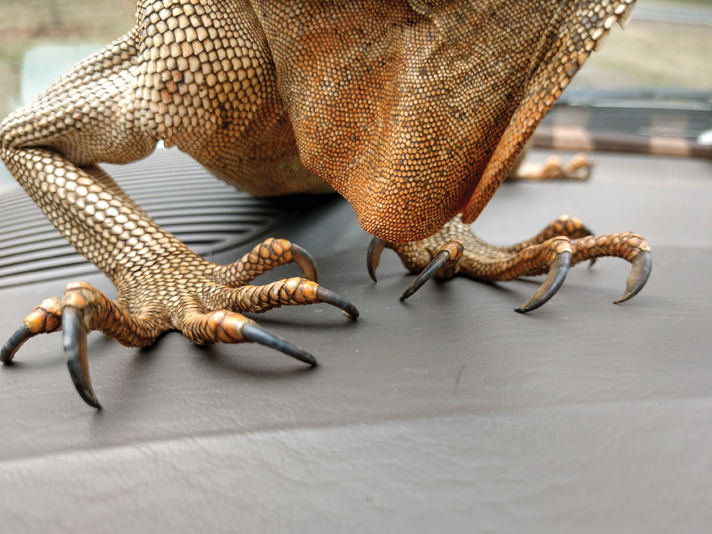
leo spinner
The untrimmed nails of a green iguana can deliver some major scratches.
Some keepers have a hard time getting past the early years of an iguana’s life. A young, new pet is sometimes slow to trust its keeper and will put up great resistance when handling is attempted. This can lead to a weary keeper who prefers to discontinue the frequent handling necessary to produce a calm adult iguana. The result, unfortunately, are green iguanas that reach their adult size without being properly socialized to humans, and such lizards often end up in rescues as being “mean” and unmanageable. This can be avoided early with proper handling and maintenance.
When handling a fidgety iguana, it is best to grasp the animal from above, gently embracing its shoulder girdle with one hand and the pelvic girdle with the other. This will prevent sudden movements that might otherwise harm the iguana.
Be patient during handling sessions, keep them up, and keep those iguana nails clipped!
Regarding Plants
Many hobbyists like to use live plants in their iguana enclosures, and live plants certainly increase the visual appeal! Its is difficult, however, to choose live plants that will not be totally destroyed by your iguana’s climbing activities, covered in waste or eaten by your pet. Therefore, the use of artificial plants as lizard habitat products may be preferred. Either way, both have their ups and downs.
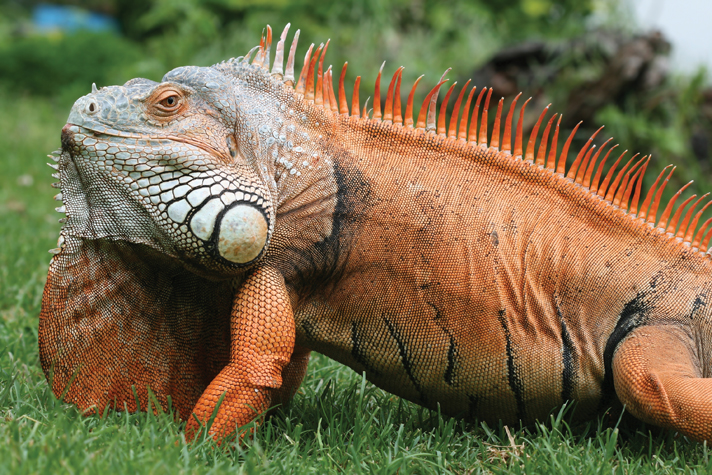
miroslav hlavko/shutterstock
Adult male green iguanas may display other vibrant colors, including orange. Note the hefty dewlap, too.
A visibly appealing enclosure can be created by using non-living pieces of once-living plants, including sections of vines or tree branches. Safe materials are available at many pet supply stores. Any such décor that you collect outdoors should be left standing, preferably indoors, for a few days to allow possible unwanted insects to find somewhere else to live. Once these items have been placed and firmly secured within the enclosure, smaller potted plants can be placed throughout, if desired. Preferred types that are readily available and harmless if eaten by your iguana would be potted palms (often available inexpensively during the spring), jade plants and Christmas or Thanksgiving cactus.
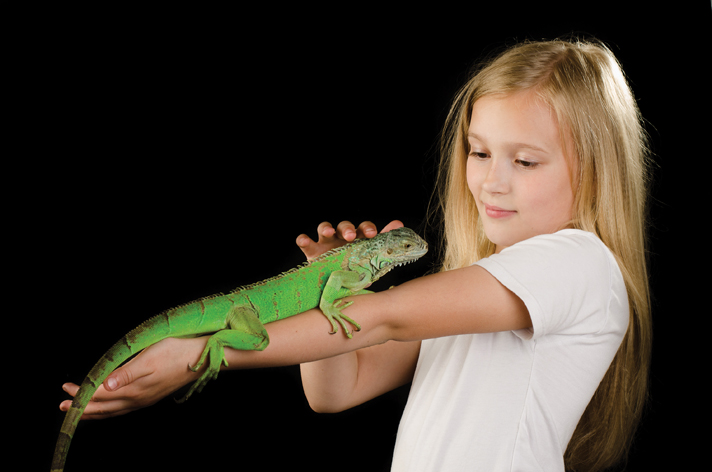
siarhei kasilau/shutterstock
Supervise children when handling pet iguanas, and make sure they wash their hands afterward.
Common spider plants are a fabulous hanging variety that thrive well in medium to high humidity. The Boston fern is another harmless, hanging plant that resembles a tropical plant but is far less demanding.
Although some live plants are tougher than others, all will need some care by the keeper, and watering, light and general management are all factors. And even if they’re not eaten, live plants can become damaged very quickly from iguanas crawling among them and digging in pots of soil, which can leave quite a mess. A large enclosure may reduce the damage to live plants, by providing iguanas easy access to other, non-planted areas.
Artificial plants provide more flexibility as far as color and variety go, and they can be purchased in many types of stores, including pet stores that sell types made specifically for use with reptiles. One of the biggest problems with artificial plants, however, is keeping them clean. Many are not easily washed and the silk varieties tend to come apart easily when cleaning is attempted, exposing wires that can be harmful to your iguana. Iguanas defecate, urinate and expel salt frequently, all of which can leave artificial plants needing almost daily cleaning.
Remember, too, that iguanas do love to eat, and if something looks like food, it will often be consumed. Silk and plastic plants may be picked at and possibly consumed by hungry iguanas, with the possibility of a blockage forming within the digestive tract.
It’s your call whether to use plants, live or artificial, but whichever direction you decide to go, pay close attention to what’s happening with them, and monitor your iguana’s behavior closely.
Green Iguana Dietary Tips
Green iguanas are primarily herbivorous, feeding strictly on plant material. There has been much debate over whether providing animal protein to captive animals is safe or not, primarily because wild iguanas have been observed feeding on invertebrates, bird eggs, fish and carrion. That said, I do not feed animal protein to my green iguanas.
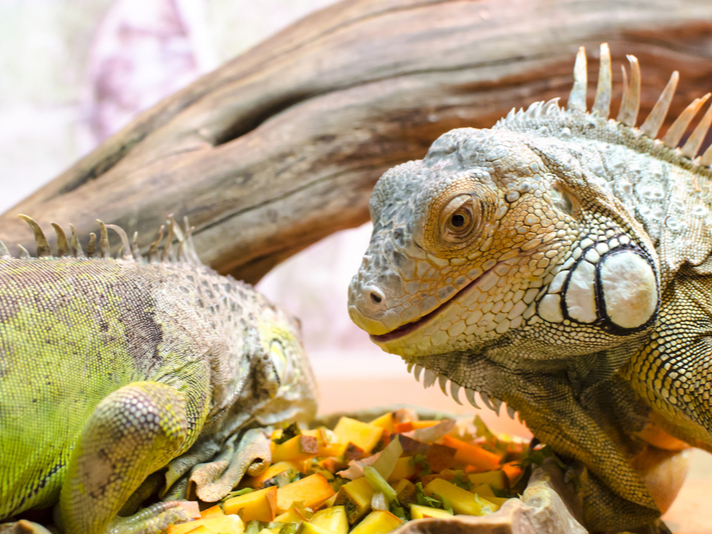
Kateryna Kon/Shutterstock
Green iguanas are primarily herbivorous, feeding strictly on plant material.
A variety of dark, leafy greens should be the main component of your green iguana’s diet. These can be provided by pre-packaged Spring Mix salad and mustard, collard and dandelion greens (and blossoms).
Fruits such as melons, mango, papaya, apple, banana, berries, etc., can be offered, but don’t overdo this or you risk causing your pet to have diarrhea. Assorted vegetables, including peas, green beans and squashes can be fed, too.
Determine how much food your iguana will eat per serving and offer this every day. Depending on the animal, you may offer a few smaller meals throughout the day or one large meal. See what your pet prefers, and be sure to remove spoiled foods promptly.
There are a multitude of vitamin and mineral supplements available for use with green iguanas, and many hobbyists use them, but I don’t. I’ve always been able to maintain healthy animals simply by providing a greens-intensive diet combined with proper UVB lighting
and temperatures.
As with any pet, a green iguana should never be purchased on impulse. Instead, much thought and research is required before considering ownership. And I cannot warn enough to maintain cleanliness for both you, after handling your pet, and your iguana’s environment — this is a crucial component to success, just as is providing proper housing, lighting and all the rest.
Follow the guidelines in this article and you are well on your way to enjoying life with a green iguana. With its amazing looks and (eventual) mellow personality — let’s face it, even with its ups and downs, there’s a reason the green iguana has remained a cherished favorite in the reptile-keeping hobby for all these years. Get one and find out why!
Leo Spinner is the owner of the Spotted Turtle Herpetological Institute (thespottedturtle.net) and Skin & Scales Live Animal Presentations. He resides with his family on Cape Cod in Massachusetts.

